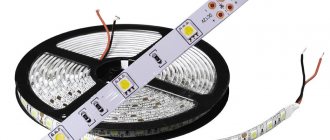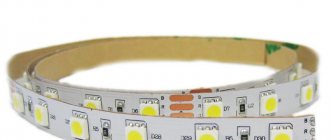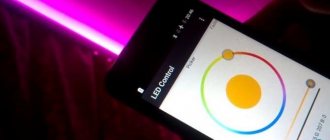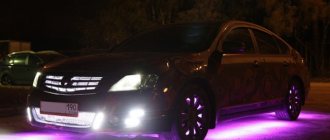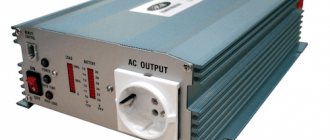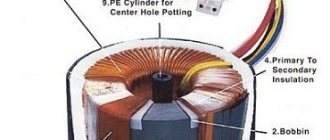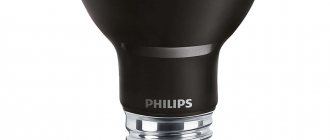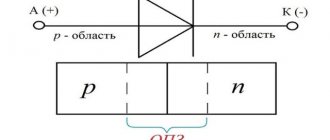LED strips are used for different purposes and every year the choice becomes wider. Stores most often offer RGB RGBW RGBWW options - not everyone knows the difference between each type, so it’s worth understanding the features in order to buy exactly what suits you best.
A visual comparison of all three varieties.
Characteristics of LED RGB strips
The main characteristics of LED RGB strips that the buyer should pay attention to are:
- Voltage . The most important point on which determines whether the tape will work in certain conditions. According to this parameter, there are 3 main types of tapes: 12V, 24V and 220V. The first is the most common option, and it is the one discussed in this article. The other two are more professional and narrowly focused options.
Incorrect voltage calculation may result in fire. Before purchasing an RGB LED strip, you must correctly calculate all the parameters.
- Diode brightness . The most common are 2 types - with a brightness of about 5 lm and 15 lm.
- Number of LEDs per meter . Everything is simple here: the more there are, the brighter. But this is not always good: you need to take into account the increasing energy consumption and heat generation, otherwise the tape will quickly fail. There are options for 30, 60 and 120 LEDs per meter. You can find models with a double row, which means they have twice as many elements.
- Moisture protection . This function will be needed if you need to place the tape in a humid environment (bathroom, bathhouse, etc.). These models may have overheating problems.
The main difference and advantage of this type of tape is that each crystal contains a red, green and blue diode. For ordinary ribbons, it has one color. Therefore, the RGB strip can light up in any desired colors.
Many people do not know the difference between a regular LED strip and an RGB strip. At the same time, the difference in price for models of the same length may differ by 2 times.
Another important difference and advantage of this option is the possibility of more flexible adjustment of the required lighting. This way you can create the necessary atmosphere and save energy, because RGB strips are controlled by a remote control with the ability to adjust not only the color, but also the brightness of the lighting.
LED strips RGB, RGBW and RGBWW
These options are polychrome, that is, multi-colored and can glow in different shades. Due to this, enormous possibilities are provided in the design of rooms and lighting of various niches or furniture.
Essentially, an LED strip is a set of resistors and semiconductors located on a printed circuit board, which is most often white to improve reflective properties.
First of all, you need to understand how multi-colored ribbons differ from single-colored ones in order to understand the general principles of operation. In monochrome tapes, the white glow is produced by a phosphor - a composition that converts electricity into radiation. The light of this option is soft and uniform. The lighting creates a comfortable atmosphere for the eyes.
The choice of shades in LED strips is huge - more than 15 million options.
In multi-color versions, all shades are formed as a result of a combination of red, blue and green (including white). Since different strips use different LEDs, the characteristics of which may vary, it is difficult to obtain the same white light as in the monochrome version, but in general it is of good quality.
This video explains the feature of RGB+W tape.
Decoding
Each type has its own characteristics, which are easy to recognize by the markings. Therefore, it is worth understanding the notation in order to navigate the topic and select the variety that suits best:
- RGB is the simplest solution, which appeared first and is still used today. It has three colors R - red, G - green and B - blue. A full-color system that consists of three monochrome channels that are connected independently of each other, which provides wide settings and a large number of possible shades.
- RGBW is an improved tape in which cold white (White) with a color temperature of 6000 K is added to the three standard colors. If you compare RGB and RGBW, the difference is in one diode, but due to it the number of shades becomes even greater, and if necessary, you can turn on pure White light.
- What does RGBWW mean? There is another white LED, but unlike the first one, it has warm white light with a temperature of 2700-2900 K.
Additional elements allow you to achieve new shades that cannot be adjusted on the standard tape.
An RGBWWW option has appeared, but it is not on sale yet; most likely, another shade of white has been added there.
Main types of RGB LED strips
Different types of tapes differ in directionality, type of glow, and additional characteristics:
- Waterproof. They are often used to decorate building facades and signs, and are installed inside aquariums and in bathrooms.
- With 3528 format LEDs. These are small diodes; more of them can fit on a strip, but they are not very bright.
- With 5050 LEDs. Larger diodes. There are fewer of them on the tape, but they are much brighter.
- RGBW tapes. They have an additional element that is responsible only for white color, which allows you to achieve more natural lighting.
- Ribbons with Pixel Light function. It is possible to set a specific program for each element separately. Such products are rarely used for home use.
Practical recommendations
When choosing LED strips, you need to rely on your needs and financial capabilities. For example, if for the required purposes you need a purple tint that should not be switched to any other color, there is often no point in purchasing a polychrome product. It is better to look for a 12 V LED strip on sale, originally manufactured in the required color. Almost any intermediate tone can be found among monochrome models - you just need to devote enough time to the search process.
When placed in wet areas or outdoors, care should be taken to ensure the safety of electrical components. Therefore, only tapes with protection class IP65 or IP68 should be mounted here. High security, of course, affects the price of the product, but it is also the key to the safety of the consumer, as well as the safety of his home and property.
Experts in the installation of lighting products argue that the installation of a four- or five-channel strip is justified only when constant dynamic lighting is provided. That is, in cases where LED products are purchased for aesthetic and decorative purposes (for a club, bar, for organizing a party, etc.), multi-color and variability will show themselves well, but in other situations this approach is unreasonable. In addition to the fact that RGBW and RGBWW tapes are noticeably more expensive than conventional three-color and monochrome ones, they are also not capable of providing significant white illumination sufficient for any task other than entertainment. Despite all the advantages, this category of products is in the nature of an auxiliary light source and cannot act as the main one.
Numerous experiments show that monochrome tape from any reputable manufacturer actually cancels out the glow from RGB models. For any purposes other than purely decorative ones, installers tend to recommend installing polychrome tape with a specific power of 7.2 to 14.4 W/m, while simultaneously supplementing it with a separate product with a white tint of the required color temperature. In the future, this will allow you to independently turn on only those tones that are necessary, not waste electricity and get sufficiently bright light lighting. The second tape can act as an additional source - then there will be enough power of the same order as the multi-color one, or it can also serve as the main local lighting - in this case, a load on it of about 20 W/m is required.
Practice shows that powerful products with white light require a fairly serious colored “partner” if the task is to comprehensively illuminate the room. For example, an SMD5050 RGB strip, equipped with 60 pcs/m LEDs and having a power of 14.4 W/m, is perfectly suited to pair with a white glow model with a power of 20 W/m. The thing is that square diodes distribute light more organically and can compete with a light shade in terms of illumination. If the balance is not maintained, it is very likely that when the products are turned on at the same time, some of the tones will not be visible at all.
Another banal recommendation from experts is that if there is a deliberate combination of two different types of tapes, it is better to follow the simplest path - purchase products with a neutral glow color. With them it will be much easier to achieve the desired color shade, including an RGB model nearby. This also applies to adjusting light lighting towards warmer or cooler tones.
One aspect to keep in mind is color distortion. When carrying out renovations in their apartments, consumers now often resort to using LED strips, including multi-color ones. To illuminate suspended ceilings, installation of products is carried out leaving a gap of at least 0.5-1 cm from the nearest ceiling. When using RGB products that do not contain white crystals, the colors of the interior items will necessarily receive a slight color deviation. The strongest effects are observed with illumination in the blue part of the spectrum. In order not to be disappointed with the result after the first turn on, it is necessary to either reconsider the coloristic concept of the backlight in advance, or take measures to balance it with other colors.
Whatever type of tape you decide to install, you should first evaluate the degree of its heating. Often, highly protected products heat up a little more than others. This is quite logical - being in a sealed shell, they cannot cool due to convection, which is why all heat removal occurs due to thermal conductivity. And this process lasts a very long time inside silicone materials and protective fills. Tapes without a shell require passive assistance - radiators with sufficient area for rapid heat removal. They are aluminum profiles, which at the same time help craftsmen lay a reinforcing base in all those places where they plan to place the lighting product. In addition, the profiles reliably protect the tape from mechanical damage caused by various sources.
Connecting RGB strip
Connecting the tapes is quite simple. There are 4 contacts: three are responsible for each color, and the fourth is for power. RGBW has another one - for white.
Connecting an RGB strip depending on the type of controller If you need to get one long strip, you can connect different strips together. The safest way to do this is by soldering, but this can be inconvenient, especially if you have no experience working with a soldering station. In this case, it is recommended to use special connectors. They come in different types:
- for connecting tapes into one;
- for connection to the power supply;
- for connecting to a 220V network;
- for different LEDs (3528, 5050, etc.).
The connectors are inexpensive and easy to install, but they oxidize quite quickly, especially in high humidity.
What is RGB backlighting
The abbreviation RGB stands for Red-Green-Blue, which in Russian means Red-Green-Blue. LED strips of this type contain three types of LED elements, in which a certain combination of glow modes allows you to create any color combination. RGB tape can also glow white, but in practice such lighting always has some shade of one of the basic colors.
For lighting engineers this is a disadvantage, but designers, on the contrary, consider this feature an advantage. If you need to get pure white, use a special type of tape, which is designated RGB+W (+White, with additional white color). As a rule, such strips are double-row and represent a combination of a regular monochrome white LED strip and an RGB lamp.
Modulation of the glow shade occurs by increasing the intensity of one of the base colors. If everyone lights up in maximum mode, then the entire tape will end up glowing white (with certain corrections). Both options - RGB and RGB+W - are controlled by a special microcomputer (controller), equipped with a remote control for easy color mode changing.
What are the characteristics of our products?
The listed methods of “setting” the desired shade of light make it possible to obtain a glow that is more pleasing to the eye. In addition, it expands the spectrum of the fundamentally narrow, usually with one line, radiation from the pn junction. RGB strips have at least 3 lines in the spectrum, RGBW – 4, and RGBWW LED strips – 5. These are the main lines; there are several more spectral emission lines with a lower brightness level.
For the average buyer, these technical subtleties manifest themselves in an increase in overall brightness and a significant increase in the quality of color reproduction. In the light of RGB, RGBW and RGBWW strips, the difference in color variations will be better perceived by vision.
Receiving any shade of white light
Lighting practice has shown that the light of RGB strips can be significantly improved. Yes, and I would like to have more brightness. The engineers proposed adding a fourth, but white one, to the three regulatory channels. A white LED was placed next to each RGB LED triad and an additional 4th control channel was connected to it. It was a pure white LED, designated W for White. Its color temperature is in the Warm range from 2600 to 3000K.
By changing the brightness of the fourth channel, you can add true white light to the “three-color” one. And as a result, get the desired shade.
But the shades of sunlight on a summer day are familiar and pleasant to humans. They correspond to a color temperature that lies in the range from 2700 to 2900K. That is, it is a warm light.
An RGB tape with a fourth W-channel can operate in the following modes:
- in multi-color adjustable with disabled W channel with changing color shades;
- in “white” RGB with the W channel disabled;
- in “white”, with hue correction using the W channel.
For example, LED RGBW strip LeDron D560 RGBW-One 2700K WWarm 10 mm. Power 19.2 W/m, LEDs – 60 pcs/m, power supply 24 Volts.
You can buy RGB, RGBW or RGBWW products directly on the website. Choose, pay and use.
The need for high brightness and a wide range of shades was realized by adding another white diode to the RGBW. We received RGBWW tapes. These are full-color RGBWW products with double color correction - warm 2600 - 3000K and “cold white” with a center of 7000K.
RGB technology
RGB is a module with the ability to configure and adjust parameters based on three primary colors.
A three-color LED consists of 3 multi-colored crystals installed in 1 housing. The required color is obtained using various combinations of the basic colors (red, blue and green). Due to the close proximity, the glow mixes. Control requires a controller that changes color according to the installed program.
Three-color LEDs are different:
- with a common anode;
- with a common cathode;
- with six terminals (without matching through the anode or cathode).
For control it is used:
- with a combined anode - supply of negative pulses to the anode;
- with a combined cathode - supply of positive pulses to the cathode;
- with six pins - any option.
Attention! Elements with six pins are the same in appearance as SMD chips.
Differences from regular tape
RGB (the same as single-color) is an elastic, narrow board with conductive tracks.
Structurally there can be three types:
- from color SMD 3528 (5050), which are soldered side by side along the entire length of the strip, the controller changes the glow intensity separately for each color;
- from three-color SMD LEDs 3528 (5050);
- from WS2812B (WS2812S) LEDs equipped with a PWM controller.
Regardless of the type of LEDs, all RGB strips are divided into analog and digital. Firstly, the chips are connected in parallel, the controller can only change the color of the strip. Secondly, each diode is connected to a microcircuit that allows the controller to control individual chips or groups of chips.
Analog RGB strips are cheaper and easier to install.
Benefits and uses
Multicolor LED strips make it possible to change the color of lighting manually or automatically, create lighting effects (flickering, shimmering), and light music.
A multi-colored source allows you to create different lighting systems:
- basic (power is selected based on the area and purpose of the room);
- additional (lighting of individual zones);
- workplace lighting;
- decorative.
In residential premises, RGB strips are most often installed around the perimeter on the ceiling or floor, in niches and arches, and on furniture. The ability to adjust the color and intensity of the glow allows you to change the atmosphere in the room and save on lighting stairs and corridors.
